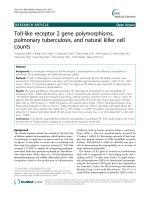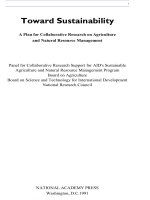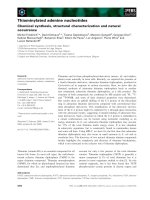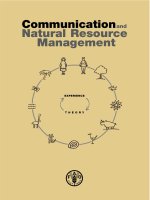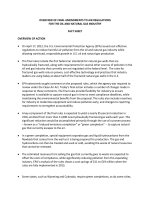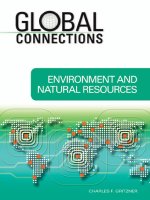Bioremediation and natural attenuation
Bạn đang xem bản rút gọn của tài liệu. Xem và tải ngay bản đầy đủ của tài liệu tại đây (11.53 MB, 614 trang )
BIOREMEDIATION AND
NATURAL ATTENUATION
ENVIRONMENTAL SCIENCE AND TECHNOLOGY
A Wiley-Interscience Series of Texts and Monographs
Edited by JERALD L. SCHNOOR, University of Iowa
ALEXANDER ZEHNDER, Swiss Federal Institute for Water Resources
and Water Pollution Control
A complete list of the titles in this series appears at the end of this volume.
BIOREMEDIATION AND
NATURAL ATTENUATION
Process Fundamentals and Mathematical Models
Pedro J. J. Alvarez
Rice University
Walter A. Illman
University of Iowa
A JOHN WILEY & SONS, INC., PUBLICATION
Copyright # 2006 by John Wiley & Sons, Inc. All rights reserved.
Published by John Wiley & Sons, Inc., Hoboken, New Jersey.
Published simultaneously in Canada.
No part of this publication may be reproduced, stored in a retrieval system, or transmitted in any form
or by any means, electronic, mechanical, photocopying, recording, scanning, or otherwise, except as
permitted under Section 107 or 108 of the 1976 United States Copyright Act, without either the prior
written permission of the Publisher, or authorization through payment of the appropriate per-copy fee to
the Copyright Clearance Center, Inc., 222 Rosewood Drive, Danvers, MA 01923, 978-750-8400,
fax 978-646-8600, or on the web at www.copyright.com. Requests to the Publisher for permission
should be addressed to the Permissions Department, John Wiley & Sons, Inc., 111 River Street,
Hoboken, NJ 07030, (201) 748-6011, fax (201) 748-6008, or online at
/>Limit of Liability/Disclaimer of Warranty: While the publisher and author have used their best
efforts in preparing this book, they make no representations or warranties with respect to the accuracy or
completeness of the contents of this book and specifically disclaim any implied warranties of
merchantability or fitness for a particular purpose. No warranty may be created or extended by sales
representatives or written sales materials. The advice and strategies contained herein may not be suitable
for your situation. You should consult with a professional where appropriate. Neither the publisher
nor author shall be liable for any loss of profit or any other commercial damages, including but not
limited to special, incidental, consequential, or other damages.
For general information on our other products and services please contact our Customer Care Department
within the U.S. at 877-762-2974, outside the U.S. at 317-572-3993 or fax 317-572-4002.
Wiley also publishes its books in a variety of electronic formats. Some content that appears in print,
may not be available in electronic format. For more information about Wiley products, visit our web site
at www.wiley.com
Library of Congress Cataloging-in-Publication Data:
Alvarez, Pedro J. J.
Bioremediation and natural attenuation : process fundamentals and mathematical models /
Pedro J. J. Alvarez, Walter A. Illman.
p. cm. – (Environmental science and technology)
Includes index.
ISBN-13 978-0-471-65043-0 (cloth)
ISBN-10 0-471-65043-9 (cloth)
1. Groundwater–Purification. 2. Groundwater flow–Mathematical models. 3.
In situ bioremediation. 4. Hazardous wastes–Natural attenuation. I. Illman,
Walter A. (Walter Arthur) II. Title. III. Series.
TD426.A483 2006
628.5–dc22 2005005175
Printed in the United States of America
10987654321
To Adela, Maria Fernanda, Cecilia Margarita, Emilia Agustina, and Celia
Argentina. For their love, patience, and contagious happiness. This book is also
dedicated to the memory of my father, Pedro Jose
´
A
´
lvarez-Chamorro, for his
unconditional support and outstanding example of how to live and how to die.
Pedro Jose
´
J. Alvarez
Siempre habra
´
nieve altanera
que vista al monte de armin
˜
o
y agua humilde que trabaje
en la presa del molino.
Y siempre habra
´
un sol tambie
´
n
-un sol verdugo y amigo-
que trueque en llanto la nieve
y en nube el agua del rı
´
o.
Versos y oraciones del caminante,
Leo
´
n Felipe
This book is dedicated to my family, Carla Marie, Walter Ricardo, and Victor
Arthur, for their unfailing love and support. They are the ones who endured me not
being around on nights and weekends to work on this book. It is also dedicated to
my parents, Hatsue Yamamoto Illman and William Richard Illman, for nurturing
and educating me to this date. Without them, I would not be where I am now.
The following classical Japanese poem signifies how we need to continue changing
and to strive to develop new technologies because life is impermanent.
Walter Arthur Illman (Yamamoto Sho)
Heike Monogatari
CONTENTS
Preface ix
1. Introduction to Bioremediation 1
2. Geochemical Attenuation Mechanisms 25
3. Biodegradation Principles 49
4. Fundamentals of Groundwater Flow and Contaminant
Transport Processes 115
5. Fate and Transport Equations and Analytical Models for
Natural Attenuation 169
6. Numerical Modeling of Contaminant Transport, Transformation,
and Degradation Processes 201
7. Field and Laboratory Methods to Determine Parameters for
Modeling Contaminant Fate and Transport in Groundwater 283
8. Bioremediation Technologies 351
9. Performance Assessment and Demonstration of Bioremediation
and Natural Attenuation 457
Appendix A. Chemical Properties of Various Organic Compounds 527
Appendix B. Free Energy and Thermodynamic Feasibility
of Chemical and Biochemical Reactions 535
Appendix C. Commonly Used Numerical Groundwater Flow and
Solute Transport Codes 543
vii
Appendix D. Nonparametric Statistical Tests for Determining the
Effectiveness of Natural Attenuation 551
Appendix E. Critical Values of the Student t-Distribution 557
Glossary 559
Index 577
viii Contents
PREFACE
Groundwater represents about 98% of the available fresh water of the planet. Thus,
protecting and restoring groundwater quality is of global strategic importance. One
common threat to groundwater resources is soil and aquifer contamination by
hazardous wastes. This widespread problem represents a significant technical and
economical challenge because underground contamination is difficult to locate
and remove by traditional extraction and excavation methods. Consequently,
there is a need for wider application of cost-effective, in situ remediation approaches
that take advantage of natural phenomena, such as bioremediation and natural
attenuation.
This book aims to provide fundamental biological, chemical, mathematical, and
physical principles related to the fate and transport of hazardous wastes in aquifer
systems, and their connection to natural attenuation and bioremediation engineer-
ing. The book is based on the authors’ extensive experience as educators, research-
ers, and consultants in environmental biotechnology and hydrogeology and is
meant to serve as a textbook for advanced undergraduate or graduate students in
environmental engineering and related sciences who are interested in the selection,
design, and operation of groundwater treatment systems. This work is also intended
to serve as a reference book for practitioners, regulators, and researchers dealing
with contaminant hydrogeology and corrective action. Thus, recent advances and
new concepts in bioremediation are emphasized throughout the book.
It is difficult to write a book about emerging technologies that have not reached
pedagogical maturity, as is the case with bioremediation and natural attenuation.
The implementation of these technologies has experienced a relatively rapid growth
in the past ten years, from negligible levels to more than 15% of all hazardous waste
site remediation approaches. Furthermore, monitored natural attenuation has been
selected for managing more than 50% of all sites contaminated by petroleum pro-
duct releases from leaking underground storage tanks. This recent increase in
demand suggests the need for a textbook that organizes, synthesizes, and analyzes
scientific and technological information to rapidly discern the applicability, merits,
and limitations of these innovative technologies. Such a text is useful not only for
process selection and performance evaluation, but also to enhance the acceptance of
bioremediation and natural attenuation as bona fide mainstream technologies. Many
decision makers have historically considered the application of biological processes
to treat natural systems as unpredictable and unreliable. Such erroneous perception
ix
dates back to the origins of bioremediation, when failures to meet the expectations
raised by technology salespeople occurred sporadically due to inadequate under-
standing of process fundamentals and inappropriate process design and implemen-
tation. We hope that this book will address such deficiencies and stimulate the
optimization and innovation of environmental biotechnologies.
We are very grateful for the encouragement and stimulating discussion and
reviews provided by our friends and colleagues, Richard Heathcote, Joe Hughes,
John McCray, Larry Nies, Gene Parkin, Michelle Scherer, Jerry Schnoor, Richard
Valentine, Timothy Vogel, Herb Ward, and You-Kuan Zhang. We thank Andy Craig
for making many of the illustrations in the book. We also would like to thank our
students in environmental engineering and earth sciences for their editorial contri-
butions and intellectual sparring. As engineering educators, we strive to build
bridges for students to link theory and sustainable practice and hope that some of
our students will maintain these bridges and build better ones for future generations.
P
EDRO J. J. ALVAREZ
WALTER A. ILLMAN
Rice University
University of Iowa
x Preface
1
INTRODUCTION TO
BIOREMEDIATION
‘‘Water, water everywhere, nor any drop to drink.’’
—The Rime of the Ancient Mariner, Samuel Taylor Coleridge
‘‘All the water that will ever be is, right now.’’
—National Geographic, October 1993
1.1. ENVIRONMENTAL CONTAMINATION BY HAZARDOUS
SUBSTANCES: MAGNITUDE OF THE CONTAMINATION
PROBLEM
Throughout human history, many societies have developed and thrived at the
expense of inefficient and unsustainable exploitation of the environment. In the
twentieth century, the tension that existed between civilization and nature grew dis-
proportionately. For example, about 39–50% of the land surface of our planet was
modified due to human activities such as agriculture and urbanization, and the
atmospheric CO
2
concentration increased by 40% over the past 140 years (mainly
due to hydrocarbon combustion and deforestation), which raises serious concerns
about global warming (Intergovernmental Panel on Climate Change 2001). Biodi-
versity has also been significantly impacted, and more than 20% of bird species
have become extinct in the last 200 years (Wilson 2002).
Many natural resources show some degree of anthropogenic impact, including
the widespread contamination of groundwater aquifers by hazardous wastes. This
is particularly significant because groundwater represents about 98% of the avail-
able fresh water of the planet (Figure 1.1). Table 1.1 provides some statistics on the
magnitude of the environmental contamination problem in the United States, and
Table 1.2 summarizes the main sources of groundwater contamination. The fact
that we are already using about 50% of readily available fresh water makes ground-
water protection and cleanup of paramount importance.
Bioremediation and Natural Attenuation: Process Fundamentals and Mathematical Models
By Pedro J. J. Alvarez and Walter A. Illman Copyright # 2006 John Wiley & Sons, Inc.
1
Oceans
97.41%
Ice caps
and glaciers
1.984%
Groundwater
0.592%
2.59%
0.014%
Lakes
0.007%
Soil
moisture
0.005%
Atmospheric
water vapor
0.001%
Rivers
0.0001%
Biota
0.0001%
Oceans
97.41%
Ice caps
and glaciers
1.984%
Groundwater
0.592%
Lakes
0.007%
Soil
moisture
0.005%
Figure 1.1. Distribution of the world’s water. Approximately 70% of the Earth is covered by water, and
fresh water accounts for less than 3% of the total amount of water available (including ice caps). Less
than 1% of the world’s fresh water (or 0.01% of all water) is usable in a renewable fashion. If ice caps
and glaciers are ignored, groundwater represents about 98% of the available fresh water. (From Speidel
and Agnew 1988.)
Table 1.1. Magnitude of the Hazardous Waste Contamination Problem in the
United States
United States generates 100 million tons of hazardous wastes per year.
In 1987, 4 million tons of toxic chemicals was released to streams, 0.87 million tons was
discharged to wastewater treatment plants, 1.2 million tons was disposed in landfills, 1.5
million tons was injected into deep wells for disposal.
There are 300,000–400,000 sites in the United States that are highly contaminated by
toxic chemicals and require remedial action.
As of 1997, cleanup activities had not began at 217,000 of these sites.
Forty million U.S. citizens live within 4 miles of a Superfund site (there are thousands of
Superfund sites).
About 440,000 out of 2 million underground tanks storing gasoline in the United States
have leaked (11 million gallons of gasoline leaked every year in the U.S., and BTEX
account for 60% of soluble components).
Fifty percent of U.S. population drinks groundwater, and 1–2% of readily available
groundwater is contaminated (1.2 trillion gal of contaminated groundwater infiltrates
every day).
According to a 1982 EPA survey, 20% of drinking water wells showed contamination by
synthetic organic chemicals. Approximately 30% of 48,000 public drinking water systems
serving populations in excess of 10,000 were contaminated, and 3% of these systems had
groundwater contamination in excess of EPA standards.
The estimated cost of environmental cleanup and management for the United States is on
the order of $1 trillion.
Sources: LaGrega et al. (1994) and NRC (1994, 1997).
2 Introduction to Bioremediation
Remediation costs for sites contaminated with hazardous wastes in Europe are
expected to exceed $1.5 trillion in the near future (ENTEC 1993). In the United
States, the Office of Technological Assessment (OTA) of the U.S. Congress esti-
mates that the cost of cleaning up more than 300,000 highly contaminated sites
will exceed $500 billion (National Research Council (NRC) 1994). This does not
include costs associated with about 440,000 sites impacted by gasoline releases
from leaking underground storage tanks (U.S. Environmental Protection Agency
(USEPA) 2003) or about 19,000 landfill sites used for disposal of municipal and
industrial wastes (USEPA 1989). Thus, there is an urgent need for cost-effective
treatment approaches.
Bioremediation—which will be broadly defined here as a managed or sponta-
neous process in which biological catalysis acts on pollutants, thereby remedying
or eliminating environmental contamination present in water, wastewater, sludge,
soil, aquifer material, or gas streams—holds great potential as a practical and
cost-effective approach to solve a wide variety of contamination problems. There-
fore, it is expected that bioremediation will play an increasingly important role in
the cleanup of soils, sediments, and groundwater contaminated with hazardous
organic chemicals.
1.1.1. Common Groundwater Pollutants
Groundwater contamination by hazardous substances is commonly the result of
accidental spills that occur during production, storage, or transportation activities.
Table 1.3 lists the top 25 hazardous groundwater contaminants in North America
and Europe. Appendix A includes a more exhaustive list of organic pollutants
that contaminate groundwater aquifers, including their physicochemical properties.
As will be discussed in the following chapters, many of these ‘‘traditional’’
hazardous wastes can be degraded by a wide variety of chemical (Chapter 2) and
biological mechanisms (Chapter 3), and bioremediation can be utilized to enhance
their removal to different degrees of efficacy.
Table 1.2. Principal Sources of Groundwater Contamination in the
United States
Leaking underground storage tanks (450,000)
Municipal solids and hazardous waste landfills (93,000)
Hazardous waste management sites (18,000)
Unlined pits, ponds, and lagoons (180,000)
Household septic systems (20 million)
Pesticide application areas (75 Â10
6
) tons/yr in Iowa)
Abandoned petroleum wells
Saltwater intrusion along the U.S. coastline
Surface spills
Sources: LaGrega et al. (1994) and NRC (1994, 1997).
Environmental Contamination by Hazardous Substances 3
The most common classes of organic groundwater pollutants include
aromatic hydrocarbons (Figure 1.2), chlorinated solvents (Figure 1.3) and pesticides
(Figure 1.4). Common inorganic groundwater pollutants include nitrate (NO
À
3
),
arsenic (As), selenium (Se), and toxic heavy metals such as lead (Pb), cadmium
(Cd), and chromium (Cr
6þ
). Such metals and radionuclides (e.g., uranium, techne-
tium, and strontium) cannot be destroyed by microorganisms. Thus, their removal
does not commonly rely on bioremediation. However, as discussed in Chapter 3,
many microorganisms can mediate oxidation–reduction reactions that decrease
the toxicity and/or mobility of these inorganic species, resulting in enhanced risk
reduction. The following discussion will focus on common priority pollutants
that are treated using bioremediation.
Petroleum Hydrocarbons
The extensive use of petroleum hydrocarbons as fuels and industrial stock has
resulted in widespread soil and groundwater contamination by this group of con-
taminants. Common sources of contamination include leaking underground storage
tanks, pipelines, oil exploration activities, holding pits near production oil wells,
and refinery wastes.
Petroleum hydrocarbons comprise a diverse group of compounds, including
alkanes, alkenes, and heterocyclic and aromatic constituents. Jet fuel, for example,
typically contains more than 300 different hydrocarbons. Gasoline, which is a very
common groundwater pollutant that is amenable to bioremediation, is also a com-
plex mixture. The most abundant gasoline constituents are generally isopentane,
p-xylene, n-propylbenzene, 2,3-dimethylbutane, n-butane, n-pentane, and toluene,
which together make up over 50% of the mixture. However, the most important
Table 1.3. The 25 Most Frequently Detected Priority Pollutants at Hazardous
Waste Sites in North America and Europe
1. Trichloroethylene (TCE) 14. Cadmium (Cd)
2. Lead (Pb) 15. Magnesium (Mg)
3. Tetrachloroethylene (TCE) 16. Copper (Cu)
4. Benzene 17. 1,1-Dichloroethane (1,1-DCA)
5. Toluene 18. Vinyl chloride
6. Chromium (Cr) 19. Barium (Ba)
7. Dichloromethane (DCM) 20. 1,2-Dichloroethane (1,2-DCE)
8. Zinc (Zn) 21. Ethylbenzene (EB)
9. 1,1,1,-Trichloroethane (TCE) 22. Nickel (Ni)
10. Arsenic (As) 23. Di(ethylhexyl)phthalate
11. Chloroform (CF) 24. Xylenes
12. 1,1-Dichloroethene (1,1-DCE) 25. Phenol
13. 1,2-Dichloroethene (1,2-DCE)
Source: NRC (1994).
4 Introduction to Bioremediation
CH
3
CH
3
CH
3
CH
3
CH
3
CH
3
Ethylbenzene
CH
2
CH
3
Be
CH
3
Toluene
(b) POLYNUCLEAR AROMATIC HYDROCARBONS
Naphthalene
Be Benzo(a)pyrene
Acenaphthene
Phenanthrene Chrysene
Dibenz(a,h)anthracene
Benzo(b)fluoranthene
Benzo(g, h, i)perylene
P
y
rene
Benzo(k)fluoranthene Indeno(1, 2, 3-cd)pyrene
p-Xylene
m-Xylene
o-Xylene
Benzene
(a) MONOAROMATIC HYDROCARBONS
Be
Fluoranthene
Be
Anthracene
Benz(a)anthracene
Fluorene
Acenaphthene
Figure 1.2. Common aromatic hydrocarbons that contaminate soils and groundwater aquifers.
C C
Cl
Cl Cl
H
C C
Cl
Cl Cl
Cl
C C
Cl
Cl H
H
C C
Cl
H H
H
Cl
HCl C C
H
Cl H
Cl
C Cl
Cl
Cl
Vinyl chloride
DCE
PCE
TCE
1,1,1 TCA
Carbon tetrachloride
CC CC
ClCl
ClCl ClCl
HH
CC CC
ClCl
ClCl ClCl
ClCl
CC CC
ClCl
ClCl HH
HH
CC CC
ClCl
HH HH
HH
ClCl
HHClCl CC CC
HH
ClCl HH
ClCl
CC ClCl
ClCl
ClCl
Figure 1.3. Common chlorinated solvents found in contaminated groundwater aquifers.
Environmental Contamination by Hazardous Substances 5
Cl
ClCl
Cl
Cl
DDT
Cl
Cl
Cl
Cl
Cl
Cl
Heptachlor
CH
3
CH
3
CH
2
Cl
n
Toxaphene
H
3
CO
S
O
OCH
3
P
O
CH
3
O
CH
3
S
O
Malathion
O
HN
O
Carbaryl
Cl
Cl
Cl
Cl
Cl
Aldrin
CH
2
Cl
Cl
Cl
Cl
Cl
Dieldrin
CH
2
O
O
Cl
Cl
Cl
Cl
Cl
Cl
Endrin
O
N
OO
P
S
O
O
Methyl parathion
O CH(CH
3
)
2
OC
O
NHCH
3
Baigon
Cl
Cl
Cl
Cl
Cl
Cl
Cl
Cl
Cl
Cl
Cl
Mirex
Cl
Cl
Cl
Cl Cl
Cl
Cl
Cl
Chlordane
N
N
CH
3
CH
H
3
C
H
3
C
OP
O
O
C
2
H
5
C
2
H
5
S
Diazinon
Organochlorides Organophosphates Carbamates
Cl
Cl Cl
Cl
Figure 1.4. Selected pesticides found in contaminated groundwater aquifers.
6
constituent from a public health risk perspective is probably benzene, which is
highly soluble (and thus highly mobile in aquifers) and is a known human carcino-
gen. Indeed, the drinking water standard for benzene (5 mg=L) is much more strin-
gent than that of other monoaromatic hydrocarbons such as toluene (1000 mg=L)
and xylenes (10; 000 mg=L), and the presence of benzene is often the driving
force for the bioremediation of gasoline-contaminated sites.
Another important group of pollutants are the polynuclear aromatic hydrocar-
bons (PAHs), which are commonly found near coal conversion facilities and petro-
leum plants. These hydrophobic pollutants are of concern to both public and
environmental health because of their tendency to concentrate in food chains
(McElroy et al. 1989) and acute toxicity (Heitkamp and Cerniglia 1988), and
some PAHs (e.g., benzo[a]pyrene) are recognized mutagens and carcinogens
(Mortelmans et al. 1986). Consequently, the U.S. Environmental Protection Agency
(EPA) has listed 16 PAH compounds as priority pollutants (Keith and Telliard 1979)
(Figure 1.2b). PAHs are the principal constituents of creosote, which is a complex
mixture of about 200 compounds also containing phenolic and heterocyclic
pollutants.
Hydrocarbons are generally lighter than water and tend to float on top of the
water table if present in a separate organic phase—the so-called light nonaqu-
eous-phase liquid (LNAPL) (Figure 1.5). However, different hydrocarbons in the
mixture exhibit different physicochemical properties that affect their transport,
fate, and principal removal mechanism. For example, short-chain alkanes tend to
be volatile and are readily stripped from groundwater whereas monoaromatic
hydrocarbons such as benzene, toluene, ethylbenzene, and xylenes (which are col-
lectively known as BTEX) (Figure 1.2a) tend to be relatively soluble and are trans-
ported over longer distances by groundwater. In fact, BTEX typically represent
about 60% of the water-soluble hydrocarbons in gasoline. Furthermore, dissimilar
hydrocarbons exhibit different levels of resistance to biodegradation. Thus, biode-
gradation and abiotic weathering processes (e.g., volatilization, sorption and dilu-
tion) result in differential removal of specific hydrocarbons, which changes the
relative composition of the hydrocarbon mixture over time.
Chlorinated Compounds
Chlorinated aliphatic and aromatic compounds make up an important group of
organic pollutants that are both ubiquitous and relatively persistent in aquifers.
Chlorinated ethenes fall into a class of chemically stable compounds commonly
known as ‘‘safety solvents.’’ Because they are resistant to combustion and explo-
sion, these compounds were widely used as industrial solvents and degreasers for
most of the twentieth century. The combination of extensive use, volatility, and
chemical stability has led to widespread contamination of groundwater and soil
by such ubiquitous and recalcitrant pollutants. Common volatile organic com-
pounds (VOCs) in the chlorinated solvents group include tetrachloroethylene
(PCE, CCl
2
ÀÀ
ÀÀ
CCl
2
), trichloroethylene (TCE, CCl
2
ÀÀ
ÀÀ
CHCl), dichloroethylene
(DCE, CHCl
ÀÀ
ÀÀ
CHCl), and vinyl chloride or chloroethylene (VC, CH
2
ÀÀ
ÀÀ
CHCl)
Environmental Contamination by Hazardous Substances 7
(Figure 1.3). All of these VOCs are potential carcinogens. Groundwater contamina-
tion by 1,1,1-trichloroethane (TCA) and chlorinated methanes, such as carbon
tetrachloride (CCl
4
) and chloroform (CHCl
3
), is also common.
Chlorinated solvents generally have a higher specific gravity than water and tend
to sink to the bottom of the aquifer if present in a separate organic phase—the so-
called dense nonaqueous-phase liquid (DNAPL) (Figure 1.5). These DNAPLs
represent a major challenge to site remediation due to their persistence and relative
inaccessibility.
Unlike the chlorinated solvents, chlorinated aromatic compounds such as hexa-
chlorobenzene and pentachlorophenol (which are common fungicides used as wood
preservers) or polychlorinated biphenyls (PCBs, which were common dielectric
fluids in transformer oil) are similar to PAHs in terms of their potential carcinogeni-
city and lipophilic nature (i.e., high affinity for fatty tissue), which is conducive to
Figure 1.5. Schematic diagram showing two types of nonaqueous-phase liquid (NAPL) spills in an
alluvial aquifer. Oil has a lower specific gravity than water and floats on the water table, forming a light
nonaqueous-phase liquid (LNAPL). Trichloroethylene (TCE), on the other hand, is heavier than water
and sinks, forming a dense nonaqueous-phase liquid (DNAPL). The dissolved phase travels with flowing
groundwater. (Adapted from Pankow and Cherry 1996.)
8 Introduction to Bioremediation
bioaccumulation. These compounds also have a strong tendency to sorb to soil and
aquifer sediments, and their dispersal is often due to cotransport with sorbents such
as colloidal matter or eroded sediments.
Pesticides
Agricultural applications of pesticide represent an important source of soil and
groundwater pollution. Pesticides that contaminate aquifers are often insecticides
and herbicides, although some fungicides and rodenticides are also found. Pesti-
cides are problematic because they are designed to be persistent (for long-lasting
action), and many are lipophilic—often accumulating in animal’s fatty tissue
through food webs.
According to their chemical structure, pesticides can be classified as orga-
nochlorides, organophosphates, and carbamates (Figure 1.4). Organochlorides
such as DDT, Aldrin, Chlordane, Endrin, Dieldrin, Heptachlor, Mirex, and Toxa-
phene represent an early generation of pesticides that are characterized by their
environmental persistence and high toxicity. Modern pesticides tend to be organo-
phosphates and carbamates. Organophosphates such as Malathion, Methyl para-
thion, and Diazinon are not as persistent in the environment but are more toxic
to humans and can be absorbed through the skin, lungs, and intestines. Carbamates
such as Carbaryl and Baigon have also some side effects at acute exposure.
Pesticides account for eight of the top-twelve list of persistent organic pollutants
identified by the United Nations Environment Programme (i.e., the UNEP ‘‘dirty
dozen’’) (Table 1.4), which are compounds that were recently banned worldwide
for production due to their ubiquitous distribution by atmospheric deposition,
high bioaccumulation potential, and propensity to affect reproduction by disrupting
the endocrine system (Figure 1.6). However, no pesticides are included in the list
of top 25 priority pollutants frequently found at hazardous waste sites in North
Table 1.4. The United Nations Environment Programme
(UNEP) List of Top Twelve Persistent Organic Pollutants
(POPs) Recently Banned from Production Worldwide
1. Dioxins
a
7. Toxaphene
2. Furans
a
8. Dieldrin
3. PCBs 9. Aldrin
4. HCB 10. Endrin
5. DDT 11. Heptachlor
6. Chlordane 12. Mirex
a
Note: Dioxins and furans represent a family of over 200 compounds that
are not produced for industrial purposes: these are toxic by-products that
may be formed during the chlorine bleaching process at pulp and paper
mills and are also released into the air in emissions from municipal solid
waste and industrial incinerators.
Source: UNEP (1999).
Environmental Contamination by Hazardous Substances 9
America and Europe (Table 1.3), which are predominantly contaminated with
industrial chemicals.
1.1.2. Emerging Pollutants
During the past decade, a wide variety of environmental contaminants have become
recognized as potentially important in the fields of environmental science and engi-
neering. These include endocrine disrupting compounds produced by the pharma-
ceutical and personal care products industries, oxidized energetic and rocket
propellants, and small ethers (Figure 1.7). In addition, there is mounting evidence
that pharmaceuticals, hormones, and other organic wastewater contaminants are
being detected in water resources throughout the United States (Kolpin et al.
2002). Little is known about the potential interactive effects of these compounds
on the biosphere.
Endocrine disrupting compounds (EDCs) are of concern to environmental health
because of their potential to bioaccumulate through food chains and affect repro-
duction (Sedlak and Alvarez-Cohen 2003). Although groundwater contamination
by EDCs is not yet a priority issue, it is important to recognize that surface
water contamination by these compounds is widespread (possibly due to atmo-
spheric transport and deposition) and that surface and groundwater resources are
interconnected. Therefore, a brief review of this emerging class of pollutants is
appropriate.
Perfluorinated octanes (PFOs) are an important class of EDCs that constitute the
building blocks of 3M’s perfluorinated surfactants, such as Scotchgard
1
. The per-
sistence of PFOs is partly due to the fact that the carbon–fluorine bond is one of the
strongest bonds in nature (110 kcal/mol). Potential adverse effects of PFOs include
bioaccumulation, interference with mitochondrial bioenergetics and biogenesis,
pesticides
atrazine,
simazine, diuron,
bentazone,
glyphosate
human/
veterinary
drugs
industrial chemicals
NTA, EDTA
bisphenol A,
nonylphenol
phthalates
natural hormones
estradiol, ß-sitosterol
Endocrine disruptors
DDT,
lindane,
amitrole,
vinclozolin
synthetic
hormones
ethinyl-
estradiol
analgesics,
lipid-lowering
agents, beta-
blockers,
antibiotics
Pesticides
atrazine,
simazine, diuron,
bentazone,
glyphosate
Human/
veterinary
drugs
Industrial chemicals
NTA, EDTA
bisphenol A,
nonylphenol
phthalates
DDT,
lindane,
amitrole,
vinclozolin
synthetic
hormones
ethinyl-
estradiol
analgesics,
lipid-lowering
agents, beta-
blockers,
antibiotics
Figure 1.6. Different classes of emerging pollutants that affect reproduction.
10 Introduction to Bioremediation
increase in liver size, neuroendocrine disruption, and acute aquatic toxicity. Due to
these concerns, the 3M Company recently decided to remove this product line from
market production.
Synthetic musk fragrances are another important class of EDCs. These are semi-
volatile compounds used for perfumes, cosmetics, soaps, shampoos, and detergents
and are commonly released by down-the-drain disposal of consumer products.
Similar to PFOs, these EDCs are subject to atmospheric distribution and deposition,
which results in widespread and worldwide contamination at trace levels.
Polybrominated diphenyl ethers (PBDEs) are also an important class of EDCs
that are often referred to as the new PCBs. These compounds are used as fire retar-
dants in electronics, plastics, car upholstery, furniture, and cables. PBDEs are also
very persistent and tend to bioaccumulate in wildlife and human tissue. An expo-
nential increase in the concentration of PBDEs has been observed in fish tissue in
the Great Lakes and in marine wildlife, and levels on the order of pg/m
3
have been
detected in human blood and milk (Snyder et al. 2003).
Oxidized rocket propellants and energetics represent another important class of
emerging pollutants and include the rocket propellants NDMA and perchlorate and
the military explosive RDX (Figure 1.7). These compounds are increasingly being
PFOS
(Perfluronated octosulfonates)
S
O
O
O-
C
8
F
17
NO
2
O
2
N
O
NO
2
O
2
N
O
Musk Ketone
(Synthetic musk fragance)
x+y=1to10
O
Br
x
Br
y
O
Br
x
Br
y
Polybrominated Diphenyl Ethers
Endocrine Disruptors
and Energetics
N
O
N
CH
3
CH
3
NDMA
(N-Nitrisodimethylamine)
Perchlorate
(ClO
4
)
O
O
Cl
O
O
-
N
N
N
NO
2
NO
2
O
2
N
RDX
Small Ethers
CH
3
CO CH
3
CH
3
CH
3
MTBE
(Methyl-tert-butyl ether)
1,4-dioxane
PFOS
S
O
O
O-
C
8
F
17
PFOS
S
O
O
O-
C
8
F
17
NO
2
O
2
N
O
NO
2
O
2
N
O
NO
2
O
2
N
O
NO
2
O
2
N
O
x+y=1to10
O
Br
x
Br
y
O
Br
x
Br
y
hers
x+y=1to10
O
Br
x
Br
y
O
Br
x
Br
y
rs
4
O
O
Cl
O
O
-
4
−
O
O
Cl
O
O
-
OO
OO
Cl
OO
OO
-
NN
NO
2
NO
2
O
2
NN
NO
2
NO
2
2
NN
NO
2
2
CH
3
CO
3
et
Oxidized Rocket Propellants
(207 PBDE con
g
eners)
Hexahydro-1,3,5-trinitro-1,3,5-triazine
Figure 1.7. Selected emerging pollutants.
Environmental Contamination by Hazardous Substances 11
found in groundwater aquifers, which is of concern due to their potential carcino-
genicity. NDMA, which can also be a by-product of wastewater chlorination, is an
extremely potent carcinogen. For example, the USEPA has proposed an action level
of 0:0007 mg=L (for 10
À6
risk), which is orders of magnitude more stringent than
the drinking water standard for common carcinogens such as benzene or trichlor-
oethylene (5 mg=L).
Groundwater contamination by small ethers is also a widespread problem. The
most common pollutants in this category are 1,4-dioxane, which is used as a chlori-
nated solvent stabilizer, and MTBE, which is a common gasoline oxygenate that is
added to minimize air pollution by hydrocarbon and carbon monoxide emissions
during combustion. These compounds are suspected carcinogens and tend to impact
large volumes of groundwater due to their high solubility, low tendency to
volatilize, and low tendency to be retarded by sorption. The recent finding that
1,4-dioxane is commonly found as a trace contaminant in chlorinated solvent
plumes has earned it the nickname of ‘‘the MTBE of the chlorinated solvent sites.’’
The remediation of sites contaminated with some emerging pollutants can be a
challenge, not only because of the persistent nature of the contaminants but also
because of logistic issues. Specifically, the chemical structure of many new pharma-
ceuticals and cosmetics are intellectual property, and standards for their analysis
may be difficult to obtain. Thus, it is very difficult to manage and control contam-
ination that cannot be accurately measured. Furthermore, there are multiple uptake
pathways for compounds such as EDCs that are probably more important than
drinking contaminated groundwater. For example, we ingest pharmaceuticals,
spray insecticides in the air, apply fragrances, and sit on couches that have both
brominated flame retardant and perfluorinated surfactant protectants. Therefore,
groundwater contamination by some of these emerging pollutants is viewed by
many decision makers as relatively low risk in relation to the groundwater
pollutants listed in Table 1.4. Consequently, this book will focus on the bioremedia-
tion of common groundwater pollutants such as hydrocarbons and chlorinated
solvents.
1.2. HISTORICAL DEVELOPMET OF ENVIRONMENTAL
BIOTECHNOLOGY AND BIOREMEDIATION
The term ‘‘biotechnology’’ is analogous to ‘‘applied biology’’ and refers to the
application of biological knowledge and techniques to develop products or to pro-
vide beneficial services. This term was coined in 1919 by the Hungarian engineer
Karl Ereky, although the use of biological processes for the production of food
products dates back to the beginning of human history (Table 1.5). Common bio-
technology products that date to ancient times include yogurt, cheese, wine, beer,
and spirits. Microorganisms are also used currently to produce large quantities of
industrial products such as organic acids, solvents, polymers, enzymes, antibiotics,
steroids, hormones, and fine chemicals for the pharmaceutical and cosmetic indus-
tries. The use of microorganisms to produce such compounds is motivated mainly
12 Introduction to Bioremediation
Table 1.5. Selected Biotechnology Landmarks
Year Event
6000
B.C. Yeast was used to make beer by Sumerians and Babylonians.
4000
B.C. The Egyptians discovered how to bake leavened bread using yeast. Other
fermentation processes were established in the ancient world, notably in
China. The preservation of milk by lactic acid bacteria resulted in yogurt.
Molds were used to produce cheese, and vinegar and wine were manufactured
by fermentation.
400
B.C. Hippocrates (460–377 B.C.) determined that the male contribution to a child’s
heredity is carried in the semen. By analogy, he guessed there is a similar fluid
in women, since children clearly receive traits from each in approximately
equal proportion.
320
B.C. Aristotle (384–322 B.C.), choosing to reject the theories of Hippocrates, told
his students that all inheritance comes from the father. The male semen, he
asserted, determines the baby’s form, while the mother merely provides the
material from which the baby is made. He suggested that female babies are
caused by ‘‘interference’’ from the mother’s blood.
A.D. 100 Romans speculated that mares can be fertilized by the wind.
1100–1700 Spontaneous generation is the dominant explanation that organisms arise from
nonliving matter. Maggots, for example, were supposed to arise from horse
hair.
1300 The Aztecs in Mexico harvested algae from lakes as a food source.
1400 While distillation of a variety of spirits from fermented grain was widespread,
Egypt and Persia largely gave up brewing as a result of the influence of Islam.
Fermented breads and cereals still maintained their hold in the African diet.
1668 Francesco Redi used an experiment to compare two competing ideas that seek
to explain why maggots arise on rotting meat. He observed that meat covered
to exclude flies did not develop maggots, while similar uncovered meat did.
This is regarded as the first disproof of spontaneous generation and was
among the first uses of a controlled experiment.
1673 Anton van Leeuwenhoek, a Dutch merchant and civic administrator who
ground glass lenses as a hobby, used his microscopes to make discoveries in
microbiology. He was the first scientist to describe protozoa and bacteria and
to recognize that such microorganisms might play a role in fermentation.
1724 Cross-fertilization in corn was discovered.
1856 In contrast to the ideas of Justis Liebig, Louis Pasteur asserted that microbes
are responsible for fermentation. His experiments in the ensuing years proved
that fermentation is the result of activity of yeasts and bacteria and
conclusively disproved the theory of spontaneous generation.
1859 Charles Darwin hypothesized that animal populations adapt their forms over
time to best exploit the environment, a process he referred to as ‘‘natural
selection.’’ He theorized that only the creatures best suited to their
environment survive to reproduce.
1863 Louis Pasteur invented the process of pasteurization, heating wine sufficiently
to inactivate microbes (that would otherwise turn the ‘‘vin’’ to ‘‘vin aigre’’ or
‘‘sour wine’’) while at the same time not ruining the flavor of the wine.
Historical Developmet of Environmental Biotechnology 13
by economic factors, since biotechnology is often less costly and environmentally
friendlier than chemical synthesis. Furthermore, biological processes can be used to
produce specific stereochemicals or complex organic molecules such as vitamin B
12
and riboflavin, which could not be feasibly produced by a chemical synthesis
process.
Similar to many industrial processes, the main motivation to use biotechnology
for environmental cleanup is also economics. For example, bioremediation is gen-
erally more cost-effective than conventional physical and chemical processes to
treat excavated soil (Table 1.6). In addition, bioremediation can be a more practical
Table 1.5. (Continued)
Year Event
1865 Gregor Mendel, an Augustinian monk, presented his laws of heredity to the
Natural Science Society in Brunn, Austria. Mendel proposed that invisible
internal units of information account for observable traits, and that these
‘‘factors’’—which later became known as genes—are passed from one
generation to the next.
1884 Robert Koch stated his ‘‘postulates’’ for testing whether a microbe is the
causal agent of a disease (i.e., (1) the suspected pathogenic organism should
be present in all cases of the disease and absent from healthy animals; (2) the
suspected organism should be grown in pure culture away from the animal
body; (3) such a culture, when inoculated into susceptible animals, should
cause disease; and (4) the organism should be reisolated and shown to be the
same as the original).
Pasteur also concurrently developed a rabies vaccine.
1900 It was first shown that key industrial chemicals (glycerol, acetone, and
butanol) could be generated using bacteria.
1909 Wilhelm Johannsen coined the terms ‘‘gene’’ to describe the carrier of
heredity, ‘‘genotype’’ to describe the genetic constitution of an organism, and
‘‘phenotype’’ to describe the actual organism, which results from a
combination of the genotype and the various environmental factors.
1914 Ardern and Lockett invent the activated sludge process to treat municipal
wastewater, and the process is first used in Salford, England.
1940–1953 Large-scale production of penicillin and cortisone was achieved.
1952 Joshua Lederberg introduces the term plasmid to describe the bacterial
structures he has discovered that contain extrachromosomal genetic material.
1953 James Watson and Francis Crick proposed the double-stranded, helical,
complementary, antiparallel model for DNA.
William Hayes discovered that plasmids can be used to transfer introduced
genetic markers from one bacterium to another.
1972 Engineered bioremediation is used for the first time to clean up a Sun Oil
pipeline spill in Ambler, Pennsylvania.
1974 Dick Raymond patents a bioremediation approach based on recirculation of
nutrient-amended groundwater.
Sources: Alleman and Prakasam (1983), Brock (1961, 1990), Bunch and Hellemans (1993), and
Hellemans & Bunch, (1988).
14 Introduction to Bioremediation
approach to clean up contaminated aquifers than traditional technologies such as
pump and treat or incineration of contaminated soil. Unlike many physicochemical
treatment processes that mainly transfer the pollutants from one phase (or location)
to another, bioremediation offers a terminal solution. Indeed, bioremediation often
destroys organic pollutants, thereby eliminating future liability costs. Therefore, it
is not surprising that bioremediation has recently gained an important place among
alternatives to clean up sites contaminated with a wide variety of hazardous wastes.
The use of biological processes for waste treatment dates back to the Roman
Empire, although the systematic design and application of microorganisms to
treat wastewater only began about one century ago. The need to treat water and
wastewater was traditionally driven by public health protection. Prior to the
Asian cholera epidemic of London (1848), deaths due to environmental contamina-
tion received little attention. In 1849, Dr. John Snow, the father of modern epide-
miology, demonstrated the connection between fecal contamination of a drinking
water source (i.e., the Broad Street water pump in London) and deaths due to cho-
lera (Stainer et al. 1986). Around that time, the discoveries of Louis Pasteur and the
etiological postulates of Robert Koch (Table 1.5) were also beginning to transform
microbiology from an observational hobby to a hypothesis-driven experimental
science. This provided the basis for the rational development of environmental bio-
technology and bioremediation.
In 1860, Pasteur demonstrated the connection between chemical changes and
microbial activities. Pasteur also proved that fermentation was a microbial process,
and in related experiments, he also conclusively disproved the theory of sponta-
neous generation (advocated by Aristotle), which held the notion that life (e.g.,
maggots) could originate from inanimate matter (e.g., horse hair).
In 1882, Dr. Angus Smith demonstrated that municipal wastewater could be
‘‘stabilized’’ by aeration, and Ardern and Lockett advanced this concept to develop
the activated sludge treatment process, which was first used in Salford, England, in
1914 (Alleman and Prakasam 1983). This process was named activated sludge
because it relied on an activated mass of microorganisms to treat the wastewater.
The development of biological treatment processes in the United States was
initiated at the Lawrence Experimental Station in Massachusetts (established
Table 1.6. Costs of Alternative Methods to Treat Soil Contaminated with
Hazardous Wastes
Treatment Method Average Cost (U.S. $/m
3
) Typical Range (U.S. $/m
3
)
Incineration 975 350–1600
Landfilling 350 100–600
Thermal desorption 125 50–200
Soil washing 237 125–350
Above-ground bioremediation 95 40–150
Adapted from Bioremediation Report (1993).
Historical Developmet of Environmental Biotechnology 15
